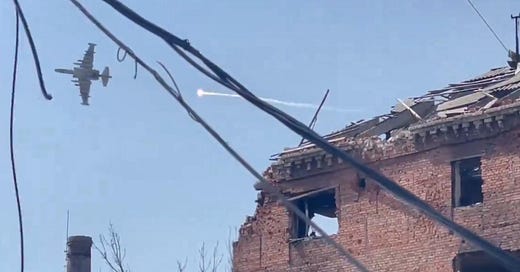Their Pilots Unafraid of Depleted Ukrainian Air-Defenses, Russian Air Force Sukhoi Su-25s Are Flying Close Air Support Around Chasiv Yar
Meanwhile, Sukhoi Su-34s drop 30 glide-bombs a day on the town
The Ukrainian garrison in Chasiv Yar has run low on, or even out of, air-defense missiles. Sensing weakness, the Russian air force has surged glide-bombers and attack jets toward the embattled town in eastern Ukraine’s Donetsk Oblast.
The Russians’ goal: to blast a gap in Ukrainian lines around Chasiv Yar—a gap through which Russian regiments can roll in order to advance into the town center. Capturing Chasiv Yar would be the first phase of a wider campaign targeting Kostyantynivka and Kramators'k, the last free cities in eastern Ukraine’s Donbas region.
After being forced from the front line by improving Ukrainian air-defenses early last year, the Russian air force pivoted. It armed its 100 or so Sukhoi Su-34 bomber with new KAB glide-bombs weighing as much as 3,300 pounds, and sortied the twin-engine, supersonic jets for stand-off bombing runs.
Launched high and fast, a winged KAB can glide as far as 25 miles—or 40 miles in its improved version. That’s just far enough to keep the Sukhois outside the range of the main Ukrainian air-defenses, when those air-defenses actually have missiles to fire.
The 3,300-pound KAB is especially destructive. “The damage done by it is very serious,” one Ukrainian soldier told CNN. “If you survive, you are guaranteed to have a contusion.” Think of it as a long-range urban demolition charge.
The Russians now are dropping as many as 100 KABs a day all along the 600-mile front line of Russia’s 26-month wider war on Ukraine. According to the Ukrainian Center for Defense Strategies, as many as 30 of them fall on Chasiv Yar every day.
Worse, the collapse of Ukrainian air-defenses around Chasiv Yar—the inevitable consequence of Russia-friendly Republicans in the U.S. Congress blocking further U.S. aid to Ukraine starting in October—means the Russian air force’s Sukhoi Su-25 attack jets safely can join the air campaign, too. The Su-25s lob unguided rockets from just a few miles away.
“Shelling of Chasiv Yar with the involvement of not only front-line bombers, but also attack aircraft, creates quite compelling grounds for the transition of local tactical successes on the ground in success at the operational level,” one Russian observer noted in a missive translated by the Estonian analyst with the handle @wartranslated.
It doesn’t help that the Ukrainian defense ministry recently yanked the volunteer 67th Mechanized Brigade from Chasiv Yar’s most vulnerable sector, its canal district, after an investigation determined that far-right officers in the brigade’s staff were sending new recruits into battle with inadequate training and support.
Totally exposed to air attack and struggling with political extremists in its ranks, the Chasiv Yar garrison reels. Reinforcing the local air-defenses might not save the town, but not reinforcing them definitely will doom it.
There’s reason for the Ukrainians to hope. Germany recently pledged to Ukraine additional air-defenses including a Patriot surface-to-air missile battery—Ukraine’s fourth. And the Republican speaker of the U.S. House of Representatives, Rep. Mike Johnson, has pledged to hold a vote on billions of dollars in U.S. aid to Ukraine this week. Aid that could pay for a lot of air-defenses.
Read more:
Fearing a Resumption of U.S. Aid to Ukraine, the Russians Are Attacking With Abandon—And Losing 80 Vehicles in a Day
When Russia-aligned Republicans in the U.S. House of Representatives blocked further U.S. aid to Ukraine starting in October, they all but handed Russia the initiative in its wider war on Ukraine. Russian regiments attacked everywhere along the 600-mile front line. Starving for amm…






